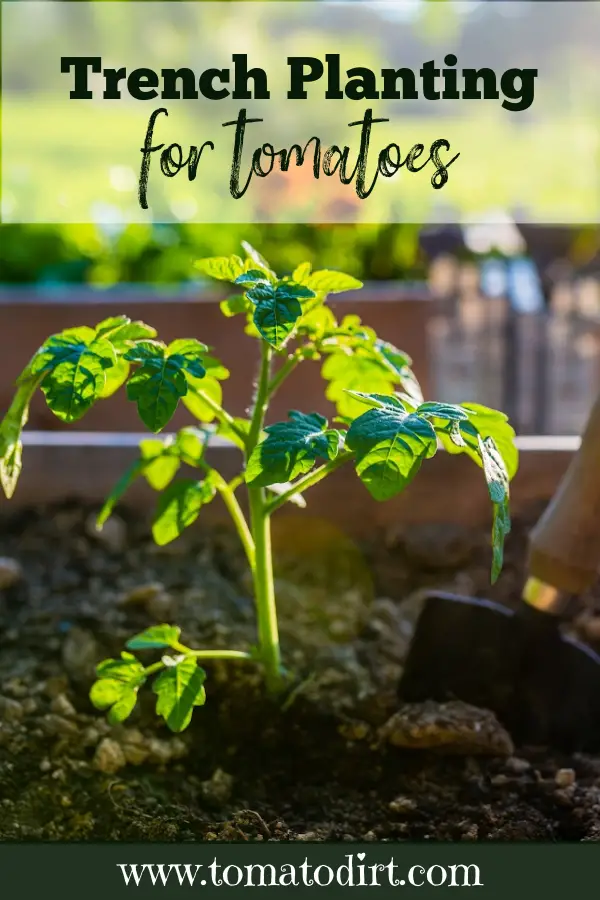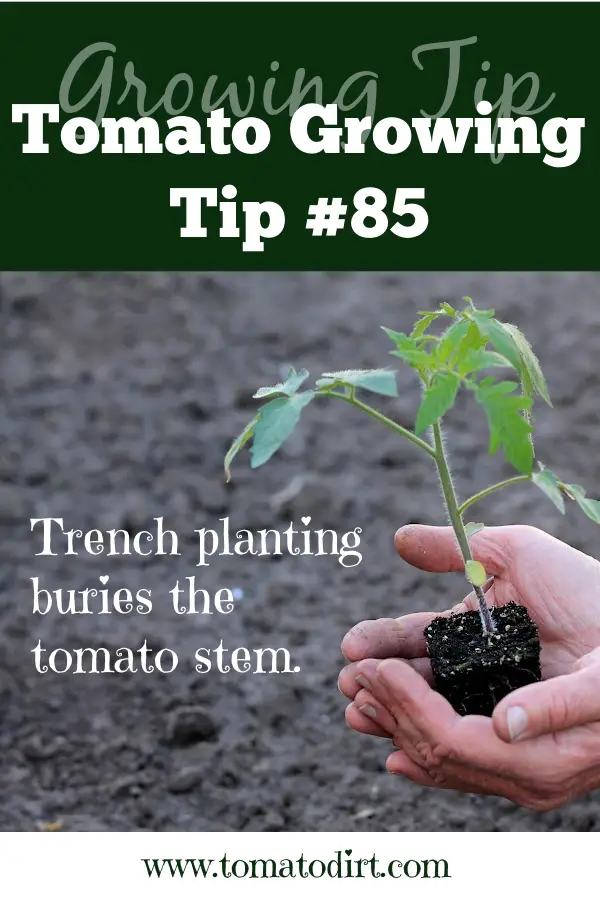FREE: 10 Must-Know Tomato Growing Tips Get The Guide
Read our affiliate disclosure here.
Trench Planting for Tomatoes: Do’s and Don’ts
Since 2010, Tomato Dirt has garnered 4.8+ million views, making it the web’s leading online source for growing tomatoes in the home garden. Award-winning writer and Tomato Dirt owner Kathy Widenhouse has helped thousands of home gardeners grow healthier tomatoes. Be one of them when you get Tomato Dirt’s Growing Guide here.
Posted 4.29.25
“Bury the stem.” That’s one way to describe trench planting for tomatoes, also known as deep planting. And it’s one of the key principles in getting your tomato plants off to a healthy start.
What is trench planting?
Trench planting is a planting technique. Instead creating individual holes for each plant, you dig a long, shallow ditch for a row of plants. Then, you lay each plant sideways in the trench and cover the stems with soil, leaving the top of the plant above ground. Trench planting is most common for tomatoes, potatoes, and squash.
Why trench planting for tomatoes is the preferable way to plant
Trench planting promotes a healthy root system
Tomatoes need strong root systems. And they have the remarkable ability to and extensive web of roots along their stems when buried deep in the soil – also called adventitious roots. By burying the stems, you provide more opportunities for adventitious roots to sprout horizontally all along the trench. The result? A stronger and more resilient root system, which allows the plant to access more nutrients and water. That means healthier growth and a bigger crop. leading to healthier growth and increased fruit production.
Trench planting aerates the soil
Dig a ditch and you loosen the soil. All those air pockets promote healthy soil microbial activity and overall plant vigor.
Trench planting stabilizes the plant
Deep planting helps anchor the tomato plant securely in the soil – especially important when tomato seedlings have become leggy. Plus, tall or top-heavy varieties are prone to tipping over in strong winds or heavy rain. But no matter the tomato variety, stems carry the bulk of a plant’s weight. Trench planting helps prevent stem breakage. Well-rooted plants are better able to withstand environmental stressors and stay upright throughout the growing season.
Trench planting protects against diseases
Burying tomato stems can also help protect against certain soil-borne diseases. Trench planting creates an additional barrier for the foliage. That reduces the risk of pathogens infecting the plant’s leaves – especially important in areas where diseases like tomato blight or tomato wilt are common.
Trench planting optimizes watering
Buried stems develop adventitious roots which reach in all directions to take up water. You can water plants more efficiently with drip watering directly along the trench, ensuring the water reaches the root system directly. Further, plants with buried stems find it easier to stay moist. Trench planting reduces the risk of water stress, which can negatively impact growth and fruit development.
How to plant tomatoes using the trench method
- Prepare the trench
Dig a trench to a depth of 6-8 inches and the length of the row. - Amend the soil
Add compost, organic matter, or fertilizer to the trench to improve soil fertility and provide nutrients for the plants. Work the amendments into the soil in the bottom of the trench. - Plant the seedlings
Place tomato seedlings along the bottom of the trench about 24-36 inches apart, depending upon the tomato variety. - Cover the lower stems
Gently push back the soil to cover the seedling’s roots and lower portion of the stem. Press the surface of the soil around the base of the tomato foliage. - Insert stakes
Place tomato cages or stakes near the base of the tomato plant just after planting. This way, the plant will have support in place but you won’t disturb the roots systems just yet. Be sure to set cage or stake points so they straddle the trench, rather than penetrate the soil along the trench so as to avoid disturbing the seedling’s root ball or puncturing the buried stem. - Water your seedlings
Water your newly planted seedlings right away. Set up a watering schedule to help plants get established and stay hydrated throughout the long season. - Mulch
Wait a couple weeks to place mulch, straw, or wood chips around the base of the plant. By postponing mulching, you allow soil to warm naturally. Mulch conserves moisture, suppresses weeds, and provides insulation for the tomato’s root system.
Extra tips when trench planting for tomatoes
Space the trench
Place trenches about 2-3 feet apart from other rows in your garden, whether or not those crops are additional tomatoes or other produce.
Plant deeply
Remove the lower leaves from your tomato seedlings. Bury the stem up to the remaining leaves. Doing so encourages additional roots to grow along the buried stem.
Expect side leaners to straighten
When you first place a tomato seedling in trench and cover the stem, the top may look skewed to one side. Be sure to gently press the soil around the entire plant. The top will not stay sideways for long. Leaves reach up to the sun. Your plants stem and foliage will upright themselves quickly – within a day or two.
What to avoid when trench planting for tomatoes
Overcrowding
Don’t lay tomato plants too closely together in the trench. Measure the distance between the tops of the plants, allowing at least 24-36 inches between them. Plants may look closer together because they are set horizontally in the ditch. Give them adequate spacing to ensure good air circulation and reduce the risk of diseases.
Breakage
Tomatoes are hardy plants but remember this: transplanting is a big event in their lives. They will be stressed. Handle them gently as you remove seedlings from their pots. Grasp the seedlings by the root ball, rather than the stems or leaves, so you don’t break or injure them.
Uneven watering
Newly transplanted tomato seedlings need regular watering in order to adjust to transplant shock. Water them daily for a week. Install drip hoses along the trench and set hoses on a water timer to ensure that your plants are on a regular watering schedule.
Bury the stem
Whether you’re planting a single tomato plant in a pot or you’re filling your garden with a few dozen tomato seedlings, give your plants their best chance for success. Plant them deeply. Yes, you can dig a deep hole. But you’ll help your plants develop stronger root systems – and do so faster – when you create a shallow trench, lay the plant on its side, and bury the stem.
More on planting tomato plants
How to Plant a Tomato Plant: A Step-By-Step Guide ...
Planting tomatoes: top tips to help your new crop succeed ...
How to harden off tomato plants to prepare them for the home garden...
When to Plant Tomatoes: A Helpful Guide ...
What’s the Best Soil for Tomato Plants?
Best and worst companion plants for tomatoes ...
Tomato transplanting mistakes to avoid when setting out plants ...
Preparing your soil for planting tomatoes in the home garden...
Get more tomato planting tips on our Pinterest board...
Return from Trench Planting for Tomatoes to Tomato Dirt home
As an Amazon Associate and Rakuten Advertising affiliate I earn from qualifying purchases.
SHARE THIS PAGE:
FREE! 10 Must-Know Tomato Growing Tips: 20-page guide
Get yours here:









